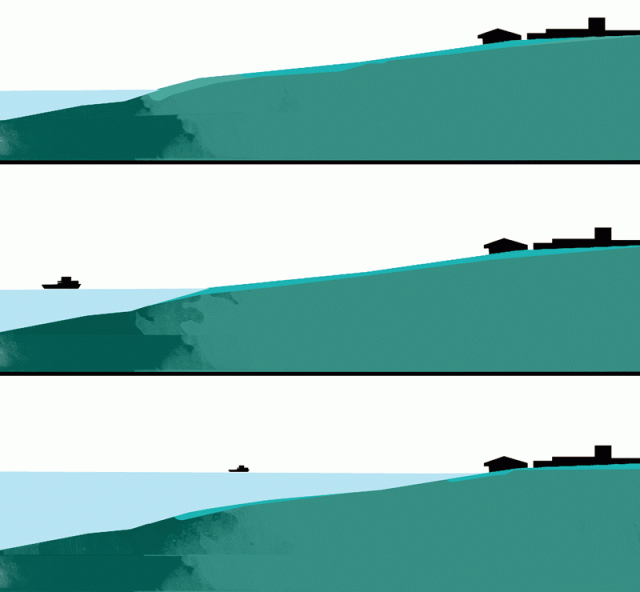Increased sea level height: various safety risks

Recently the 23rd session of the International Forum Conference of Parties (Cop-23), organized by Fiji in the Forestry of Germany, was completed. There have been many other security concerns about climate change in many other areas. One of these is the increase in sea level height and associated security risk. In the speech of President of Fiji, George Conorto, the details of the existence of the sea level elevation on the small islands will be created. But this risk is not only on small island states, but there is also little risk of coastal low-lying countries all over the country. Bangladesh is in the first row. All of the negative impacts of sea level rise, which are all over the world, are especially applicable to Bangladesh. Analysis shows that due to the increase in sea level elevation, there will be many upcoming and long-term negative effects on the world.
Most people have the role of raising sea level height. In keeping with modern living, various activities of human beings have been directly or indirectly contributing to the increase in global warming. As the temperature increases according to science sources, the volume of water also increases. Apart from this, the height of the water has increased due to the melting of ice in the polar regions and the mountains. According to the scientists' prediction, if the present rate of temperature rise continues, by the year 2100 sea level height can increase from 11 to 38 inches. If there is a major breakdown in Greenland and West Antarctica, it can have a worse effect.
As the increase in sea level height, the lowest countries in the world will be the worst affected, among which one is Bangladesh. A study by the Intergovernmental Panel for Climate Change (IPCC), an intergovernmental organization on Climate Change, says that if the height of sea level is increased by 1 meter (39.37 inches), 17-20 percent of the country's lands will be submerged in water. According to the National Policy of Bangladesh on Climate Change, it will result in 25 million people becoming Climate-Refugees. However, independent research says that the number can reach from 3 to 350 million.
A recent NASA study says that in the next 100 years, the port city of Bangladesh is at risk of disappearing in the sea. Due to the huge population of Bangladesh and limited resources, transfer of environment-refugees to other places will be difficult. Bangladesh is surrounded by tremors in three directions. If a large number of refugees try to cross this barbed wire, then it demands deeper analysis of what will happen. But it can be said without doubt that sea level elevation is not limited to the security of Bangladesh and it will be at risk for inter-regional and regional security.
Some island states will be most affected due to rise in sea level. Maldives, Papua New Guinea and the small islands located in the Pacific are completely submerged in water. These countries will become unfit to live before they are completely submerged. In addition, East Asia, Middle East and North Africa are at risk. It may be mentioned here that 8 of the world's largest 10 megacities are located in the coastal areas. Two-thirds of the world's inhabitants live within 100 kilometers of sea level. So, due to the increase in sea level height, a large number of people are at risk of displacement. Developing countries like Bangladesh, whose resources are limited, will be harder to overcome this loss.
As the increase in sea level height, the existing marine boundaries of different countries will be changed. If the islands are completely submerged, the control of adjacent seacoastes will be lost. Due to slight changes in the boundaries, the United States Convention on the Law of the Sea (UNCLOS) will change the maritime boundaries. As a result, there could be disputes between different countries on the changed maritime boundary. There will be conflict between the special economic zones in the sea and the access to the deep sea. Conflicts of interpolation will also cause conflict.
Increased sea level elevation will have adverse effects on the livelihood of the people. Various types of crop production will be hampered due to saline water infections and the quality of the crops will be changed. According to the study, the increase in sea temperature, changes in depth, and changes in the quality of the chemical quality of the water will destroy many species of fish. Many marine creatures will be wiped out. Because the increase in sea level height will hinder the normal process of inhalation, ecology and physical growth.
Food security will be severely disrupted. Mainly as abundant agricultural land will be submerged in water and if not too large, it will reduce the production capacity due to the entry of saline water. Irrigation will be difficult due to salt infections and consequently the crop production will be much lower than expected. Large quantities of rice production will be hampered by the closure of the Mekong River in Vietnam and the adjacent areas of the Red River in the United States.
A study report of Bangladesh Food Security Investment Forum 2010 says that Rice production of Bangladesh is at risk of decreasing by 3.9 percent every year till 2050. Due to acute salinity, water safety is also at risk. Different sources of water will be affected by saline water.
http://www.prothom-alo.com/opinion/article/1373286/